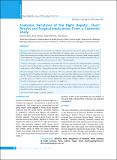Please use this identifier to cite or link to this item:
https://hdl.handle.net/20.500.14356/1441Full metadata record
| DC Field | Value | Language |
|---|---|---|
| dc.contributor.author | Kafle, Akinchan | - |
| dc.contributor.author | Adhikari, Bidur | - |
| dc.contributor.author | Shrestha, Rajani | - |
| dc.contributor.author | Ranjit, Nirju | - |
| dc.date.accessioned | 2023-05-11T07:32:44Z | - |
| dc.date.available | 2023-05-11T07:32:44Z | - |
| dc.date.issued | 2019 | - |
| dc.identifier.citation | KafleA., AdhikariB., ShresthaR., & RanjitN. (2019). Anatomic Variations of the Right Hepatic Duct: Results and Surgical Implications From a Cadaveric Study. Journal of Nepal Health Research Council, 17(01), 90-93. https://doi.org/10.33314/jnhrc.v17i01.2012 | en_US |
| dc.identifier.issn | Print ISSN: 1727-5482; Online ISSN: 1999-6217 | - |
| dc.identifier.uri | http://103.69.126.140:8080/handle/20.500.14356/1441 | - |
| dc.description | Original Article | en_US |
| dc.description.abstract | Abstract Background: Right hepatic duct, formed by the confluence of the anterior and posterior right sectorial ducts, joins left hepatic duct to form common hepatic duct. This fashion of confluence does not prevail in all cases. The sectorial ducts can aberrantly meet left duct and rest of the ducts from the left lobe of liver. Presence of such variation imposes clinical importance during peri-hilar, split liver transplant surgery or cholecystectomy. Nepalese population has not been explored before disregarding clinical necessity as MRI or cholangiography. Methods: Descriptive cross sectional study was conducted in 107 cases dissecting the main portal fissure separating hemi liver and extrahepatic biliary confluences. Methylene blue dye was injected and bile duct wall was cut open to the study pattern of the confluence. Data analysis was done with Statistical Package for Social Sciences (SPSS) version 17. Results: Normal variant of confluence was found in 72% cases, aberrant right posterior sectorial duct joins left hepatic duct in 9.3% and aberrant right anterior duct or low insertion of the right posterior sectorial duct was found in 1.9%. 9.3% of cases there is no true right hepatic duct often described as triple confluence. 0.9% cases showed no particular pattern of confluence where common hepatic duct is formed by multiple confluence. Quadrate lobe was found to be draining into right anterior sectorial duct in a single case. Conclusions: Right hepatic duct confluence pattern is variable and all the evidence occurs at the main portal fissure. Right sectorial duct may join the left duct avoiding normal confluence pattern. Right posterior sectorial duct may be inserted low in the common bile duct. Keywords: Duct; hepatic; sectorial; variation. | en_US |
| dc.language.iso | en | en_US |
| dc.publisher | Nepal Health Research Council | en_US |
| dc.relation.ispartofseries | Jan-March, 2019;2012 | - |
| dc.subject | Duct | en_US |
| dc.subject | Hepatic | en_US |
| dc.subject | Sectorial | en_US |
| dc.subject | Variation | en_US |
| dc.title | Anatomic Variations of the Right Hepatic Duct: Results and Surgical Implications From a Cadaveric Study | en_US |
| dc.type | Journal Article | en_US |
| local.journal.category | Original Article | - |
| Appears in Collections: | Vol. 17 No. 1 Issue 42 Jan - Mar 2019 | |
Files in This Item:
| File | Description | Size | Format | |
|---|---|---|---|---|
| 2012-Manuscript-9277-1-10-20190429.pdf | Fulltext Download | 567.25 kB | Adobe PDF |  View/Open |
Items in DSpace are protected by copyright, with all rights reserved, unless otherwise indicated.
